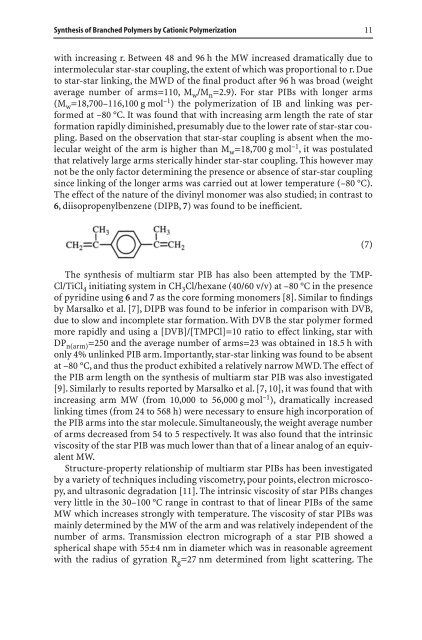142 Advances in Polymer Science Editorial Board: A. Abe. A.-C ...
142 Advances in Polymer Science Editorial Board: A. Abe. A.-C ...
142 Advances in Polymer Science Editorial Board: A. Abe. A.-C ...
Create successful ePaper yourself
Turn your PDF publications into a flip-book with our unique Google optimized e-Paper software.
Synthesis of Branched <strong>Polymer</strong>s by Cationic <strong>Polymer</strong>ization 11<br />
with <strong>in</strong>creas<strong>in</strong>g r. Between 48 and 96 h the MW <strong>in</strong>creased dramatically due to<br />
<strong>in</strong>termolecular star-star coupl<strong>in</strong>g, the extent of which was proportional to r. Due<br />
to star-star l<strong>in</strong>k<strong>in</strong>g, the MWD of the f<strong>in</strong>al product after 96 h was broad (weight<br />
average number of arms=110, M w /M n =2.9). For star PIBs with longer arms<br />
(M w =18,700–116,100 g mol –1 ) the polymerization of IB and l<strong>in</strong>k<strong>in</strong>g was performed<br />
at –80 °C. It was found that with <strong>in</strong>creas<strong>in</strong>g arm length the rate of star<br />
formation rapidly dim<strong>in</strong>ished, presumably due to the lower rate of star-star coupl<strong>in</strong>g.<br />
Based on the observation that star-star coupl<strong>in</strong>g is absent when the molecular<br />
weight of the arm is higher than M w =18,700 g mol –1 , it was postulated<br />
that relatively large arms sterically h<strong>in</strong>der star-star coupl<strong>in</strong>g. This however may<br />
not be the only factor determ<strong>in</strong><strong>in</strong>g the presence or absence of star-star coupl<strong>in</strong>g<br />
s<strong>in</strong>ce l<strong>in</strong>k<strong>in</strong>g of the longer arms was carried out at lower temperature (–80 °C).<br />
The effect of the nature of the div<strong>in</strong>yl monomer was also studied; <strong>in</strong> contrast to<br />
6, diisopropenylbenzene (DIPB, 7) was found to be <strong>in</strong>efficient.<br />
The synthesis of multiarm star PIB has also been attempted by the TMP-<br />
Cl/TiCl 4 <strong>in</strong>itiat<strong>in</strong>g system <strong>in</strong> CH 3Cl/hexane (40/60 v/v) at –80 °C <strong>in</strong> the presence<br />
of pyrid<strong>in</strong>e us<strong>in</strong>g 6 and 7 as the core form<strong>in</strong>g monomers [8]. Similar to f<strong>in</strong>d<strong>in</strong>gs<br />
by Marsalko et al. [7], DIPB was found to be <strong>in</strong>ferior <strong>in</strong> comparison with DVB,<br />
due to slow and <strong>in</strong>complete star formation. With DVB the star polymer formed<br />
more rapidly and us<strong>in</strong>g a [DVB]/[TMPCl]=10 ratio to effect l<strong>in</strong>k<strong>in</strong>g, star with<br />
DP n(arm) =250 and the average number of arms=23 was obta<strong>in</strong>ed <strong>in</strong> 18.5 h with<br />
only 4% unl<strong>in</strong>ked PIB arm. Importantly, star-star l<strong>in</strong>k<strong>in</strong>g was found to be absent<br />
at –80 °C, and thus the product exhibited a relatively narrow MWD. The effect of<br />
the PIB arm length on the synthesis of multiarm star PIB was also <strong>in</strong>vestigated<br />
[9]. Similarly to results reported by Marsalko et al. [7, 10], it was found that with<br />
<strong>in</strong>creas<strong>in</strong>g arm MW (from 10,000 to 56,000 g mol –1 ), dramatically <strong>in</strong>creased<br />
l<strong>in</strong>k<strong>in</strong>g times (from 24 to 568 h) were necessary to ensure high <strong>in</strong>corporation of<br />
the PIB arms <strong>in</strong>to the star molecule. Simultaneously, the weight average number<br />
of arms decreased from 54 to 5 respectively. It was also found that the <strong>in</strong>tr<strong>in</strong>sic<br />
viscosity of the star PIB was much lower than that of a l<strong>in</strong>ear analog of an equivalent<br />
MW.<br />
Structure-property relationship of multiarm star PIBs has been <strong>in</strong>vestigated<br />
by a variety of techniques <strong>in</strong>clud<strong>in</strong>g viscometry, pour po<strong>in</strong>ts, electron microscopy,<br />
and ultrasonic degradation [11]. The <strong>in</strong>tr<strong>in</strong>sic viscosity of star PIBs changes<br />
very little <strong>in</strong> the 30–100 °C range <strong>in</strong> contrast to that of l<strong>in</strong>ear PIBs of the same<br />
MW which <strong>in</strong>creases strongly with temperature. The viscosity of star PIBs was<br />
ma<strong>in</strong>ly determ<strong>in</strong>ed by the MW of the arm and was relatively <strong>in</strong>dependent of the<br />
number of arms. Transmission electron micrograph of a star PIB showed a<br />
spherical shape with 55±4 nm <strong>in</strong> diameter which was <strong>in</strong> reasonable agreement<br />
with the radius of gyration R g=27 nm determ<strong>in</strong>ed from light scatter<strong>in</strong>g. The<br />
(7)
















